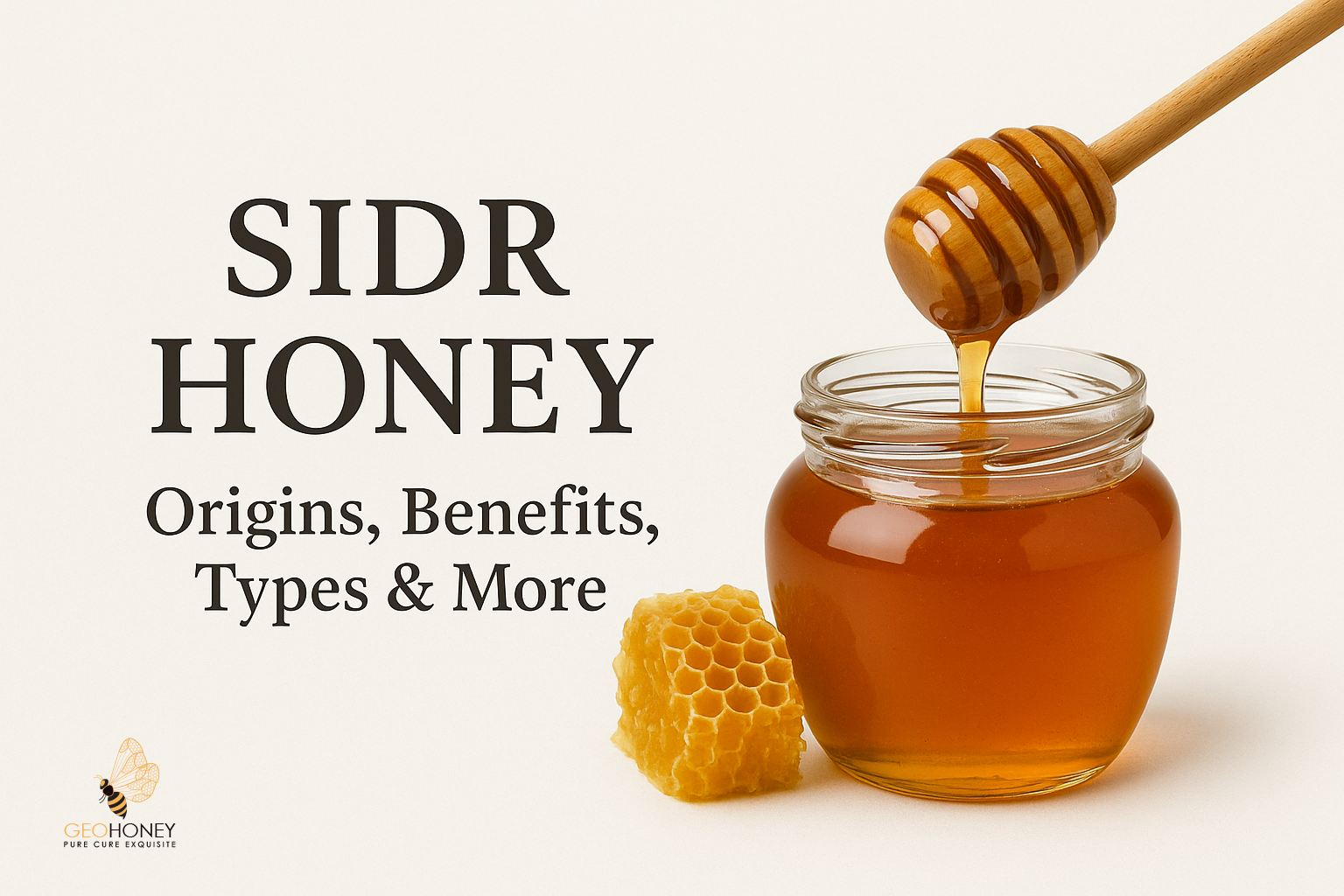- Tokyo: 18:37
- Singapore: 17:37
- Dubai: 13:37
- London: 09:37
- New York: 04:37
Sidr Honey: Origins, Benefits, Types & More
- Reading Time: 2 minutes, 43 seconds
- Post Views: 1327
What is Sidr Honey?
Sidr honey is a premium monofloral honey made by bees that feed exclusively on the nectar of the Sidr tree (Ziziphus spina-christi). It is renowned for its rich taste, golden to dark amber color, thick texture, and powerful medicinal properties. Often considered one of the world’s finest and most expensive honeys, it holds a special place in both traditional medicine and cultural heritage.
Sidr Honey Origins
The Sidr tree, also called the Lote tree or Jujube tree, is native to arid and semi-arid regions. It has been revered for thousands of years, mentioned in ancient texts and Islamic tradition as a tree of blessing and healing.
The main regions known for producing Sidr honey include:
Yemen: Famous for Do’an Valley Sidr Honey, considered the purest and most valuable.
Pakistan: Produced in Karak and Khyber Pakhtunkhwa, popular in South Asia.
India: Found in Rajasthan and Gujarat, offering a distinct floral taste.
Sudan & Egypt: Lighter in color and widely consumed locally.
Because the Sidr tree blooms only once or twice a year, pure Sidr honey is rare and highly valued.
Types of Sidr Honey
There are several varieties depending on origin and taste:
Yemeni Sidr Honey: Rich, thick, aromatic, and the most expensive.
Pakistani Sidr Honey: Affordable, smooth in taste, and widely available.
Indian Sidr Honey: Slightly floral with a lighter aftertaste.
Sudanese & Egyptian Sidr Honey: Lighter color, less dense, but still medicinal.
Nutritional Value of Sidr Honey
Sidr honey is packed with essential nutrients:
Natural Sugars: Glucose & fructose
Vitamins: B-complex, Vitamin C
Minerals: Iron, calcium, potassium, magnesium, zinc
Antioxidants: Phenolic compounds, flavonoids
Enzymes: Catalase, glucose oxidase
This composition makes it an excellent natural energy booster and healing agent.
Health Benefits of Sidr Honey
Sidr honey is widely recognized in both traditional medicine and modern research for its healing power:
Boosts Immunity: Rich in antioxidants and antibacterial compounds.
Improves Digestion: Helps with ulcers, acid reflux, and gastritis.
Wound Healing: Natural antiseptic for burns, cuts, and skin infections.
Respiratory Health: Relieves cough, sore throat, asthma, and flu symptoms.
Energy & Stamina: Provides natural, long-lasting energy.
Reproductive Health: Traditionally used for fertility and vitality.
Skin & Beauty: Reduces acne, scars, and hydrates skin naturally.
Cultural & Religious Importance
In Islam, the Sidr tree and its honey are mentioned in the Quran and Hadith, symbolizing blessings and healing.
Used in Ayurveda and Unani medicine for centuries.
Considered a luxury honey, often gifted during special occasions in the Middle East.
How Sidr Honey is Harvested
Harvested during the short Sidr flowering season (once or twice a year).
Traditional beekeepers in Yemen and Pakistan use natural hives without chemicals.
Honey is extracted manually, unheated, and unfiltered to preserve nutrients.
How to Identify Pure Sidr Honey
Because it is expensive, Sidr honey is often adulterated. Genuine Sidr honey has:
A thick consistency (does not crystallize quickly).
Distinct aroma of Sidr flowers.
Golden to dark amber color.
A strong, long-lasting aftertaste.
A premium price (cheap Sidr honey is usually fake).
Uses of Sidr Honey
Culinary: Sweetener for tea, desserts, and natural drinks.
Medicinal: Taken raw for immunity, digestion, and healing.
Cosmetic: Used in skincare masks and natural remedies.
Religious & Cultural: Considered sacred and gifted in Middle Eastern traditions.
Market Value of Sidr Honey
Yemeni Sidr Honey: $150 to $500 per kg (most premium).
Pakistani & Indian Sidr Honey: $30 to $100 per kg.
Egyptian & Sudanese Sidr Honey: $20 to $70 per kg.
Its high price is due to limited supply, labor-intensive harvesting, and global demand.
Conclusion
Sidr honey is more than just a natural sweetener; it is a treasured medicinal honey with centuries of cultural, religious, and health significance. Whether consumed for its healing properties, immune support, or unique taste, Sidr honey remains one of the most luxurious and beneficial honeys in the world.











